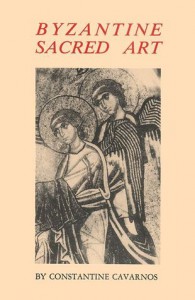Thus Spake Dustin
I love reading about Eastern Orthodoxy, scripture, and nonfiction works that challenge me to expand my view of the world.
Review of Byzantine Sacred Art by Constantine Cavarnos

Constantine Cavarnos, Byzantine Sacred Art: Selected Writings of the Contemporary Greek Icon Painter Fotis Kontoglous on the Sacred Arts according to the Tradition of the Eastern Orthodox Christianity, Compiled, Translated from the Greek, and Edited with a Preface, Introduction, Notes, and Illustrations, 2nd Edition, Revised and Considerably Enlarged (Belmont, MA: Institute for Byzantine and Modern Greek Studies, 1992). Pp. 171.
This book starts with an introduction by Cavarnos, and then it presents a series of essays by Photios Kontoglou (note, some editions present his name as Fotis Kontoglous), who is a famous Greek artist of Orthodox iconography. Kontoglou is such a big name in this field because he played a large part in reviving traditional Cretan-style iconography around the world. For this reason alone, one should stop to pay attention to what he has to say about Byzantine art. However, with that having been said, in some respects I completely disagree with his conclusions.
For Kontoglou, Orthodox iconography – what he calls Byzantine art – is the pinnacle of all art. It is the pinnacle because he believes the very essence of iconography is different than other forms of art (Renaissance, Impressionism, etc.). For him, the essence of an icon participates in the mystery of Christ and salvation. It isn’t an imitation of the natural world, but rather a revelation of and participation in a spiritual reality.
One also gets the sense that Kontoglou has been criticized for his stance on Byzantine art. According to him, many have criticized his art – and Byzantine art – as being primitive in form, unnaturalistic, and slavish copies. He labors at length arguing that Byzantine art is none of these observations precisely because this art is working on a completely different “level” than secular art – in short, it’s not about the artist’s skill, or how well a piece of art represents nature, or how a piece of art makes a profound statement.
My critique of his argument falls on the level of semiotics. I believe he has confused the 'sign' for the 'object' it should represent. His argument is largely based on the *style* of the icon. He believes that *how* one represents Christ and the saints (the artistic style) is an indication of its inner essence. This would be like saying that the letters T-R-E-E can only represent that large thing with a trunk, limbs, and leaves if they are written in New Times Roman, but if you write those letters in Arial, for example, you no longer are talking about the same thing. This, of course, doesn’t hold up. I would argue that what matters for iconography is the composition of the figures so that it continues to illustrate a precise theological point. In short, I’m saying as long as the letters are T-R-E-E, the style, or font, doesn’t matter. What matters is that it still points to the same object (or theological idea).
One could further illustrate this point by pointing to an image I’ve seen of a pagan god – I believe he had antlers coming from his head. The catch is, however, that this pagan god was painted in the Byzantine style. Just because it adheres to the traditional style of iconography, does not mean that it points to an Orthodox theological truth.
My second objection to this work is the use of “Byzantine.” Because this is also the word used for the Eastern Roman Empire, I’m hesitant to tie religious painting to a fallen empire because worshipers around the world are still praying before these works of art. In short I see “Byzantine” as a political word, and I wish he would have stressed the connection of this art with the Orthodox Church. My preference would have been to simply call this art, “iconography.” Also, by using the word “Byzantine,” he’s able to stress a particular style over other styles (for example, what’s called Russian mannerism – the style of Andrei Rublev). Where does Russian, Bulgarian, Serbian, Romanian, etc. iconography fit into his thesis?
The third objection to this work is that most of his essays are simply an exercise of name-dropping. For example, the chapters on Mt. Athos, Yugoslavia, Bulgaria, and the various chapters about the icons of different feasts, are simply catalogs of where particular icons exist, who painted them, and what they look like. There’s very little explanation – theological or otherwise – that draws the reader deeper into the “mystery,” as he might say. I would ask, to what do these particular icons point? What is their meaning?
One discussion that I thought was worthwhile was the discussion about the Greeks under the Ottomans. Here he makes a connection between icons of suffering (the crucifixion, extreme humility, poor Lazarus, etc.) and the suffering of the people under their political suppressors. This is an interesting idea, and I would like to see it fleshed out a bit.
In short, if you’re really into iconography, you may want to check this book out. However, if you’re new to iconography and you’re looking for an introduction that really explains the theology of icons, how to understand them, and how they are used by the Orthodox Church, you may want to look elsewhere.



